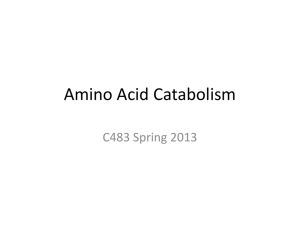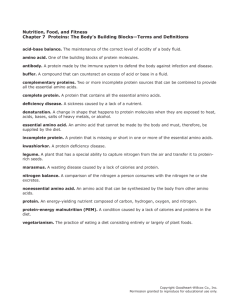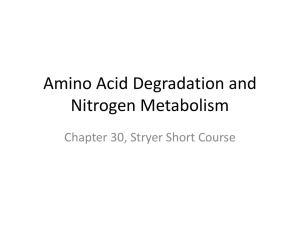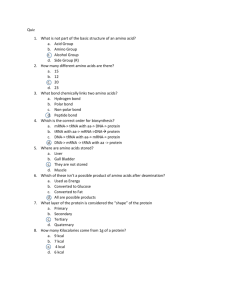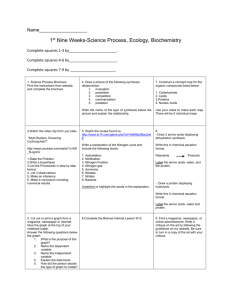Metabolism of nitrogen compound
advertisement
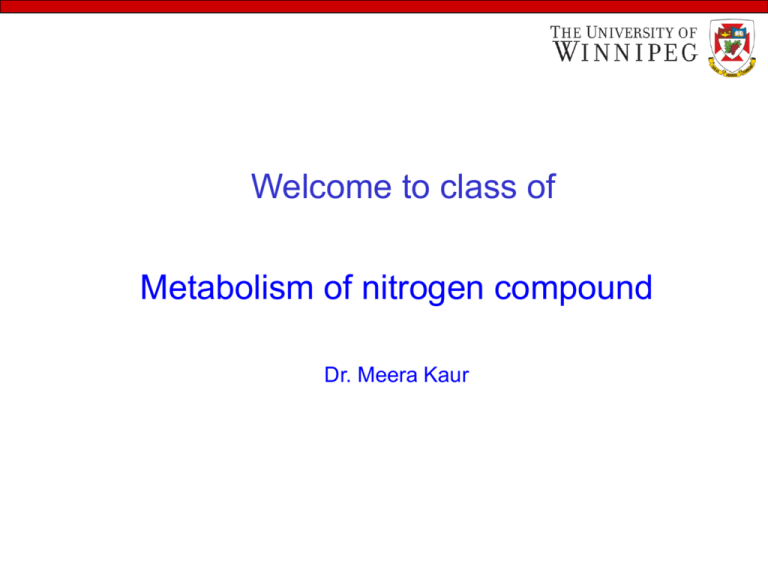
Welcome to class of Metabolism of nitrogen compound Dr. Meera Kaur Learning objectives • To understand: – The process by which atmospheric nitrogen is made available to plants and animal. – To understand the transamination reactions. – The reaction of oxidative deamination. – The reactions of urea cycle. – The inborn errors of amino acid metabolism Nitrogen fixation Nitrogen enters the biosphere by nitrogen fixation • Few plants can from nitrogen- containing compounds from nitrogen in air, no animals can, but certain bacteria can. It is through nitrogen-fixing bacteria that atmospheric nitrogen enters the biosphere- the domain of living things. Nitrogen-fixing bacteria reduces atmospheric nitrogen to ammonia, a water soluble form of nitrogen that can be used by plants and animals. • Plants and animals incorporate ammonia into nitrogen compound such as proteins. The plants and animal die and decay, aided by other bacteria. Decaying matter returns nitrogen to the soil as ammonia, nitrite ions or nitrate ions, Moreover, some nitrogen gas is returned to the atmosphere. This flow of nitrogen between the atmosphere and, the earth with its living creatures is the nitrogen cycle. Root nodules from clover The nitrogen cycle Protein turnover Proteins are continuously hydrolyzed and synthesized by the body • In the human body dietary proteins are hydrolyzed to their constituent amino acids as a part of digestion. Many of the body’s proteins are continuously hydrolyzed and synthesized within the cells. This dynamic process is called protein turnover. • The enzymes responsible for intracellular hydrolysis of proteins are cathepsins — a class of peptidases similar to trypsin, peosin and chymotrypsin. • In cells, the cathepsins are confined to the lysosomes, where the protein degradation occurs. • We have already discussed about translation— the process of protein synthesis. Amino acid metabolism Amino acids meet several cellular needs • Amino acids produced by digestion of dietary protein and during protein turnover in the body cells become part of the body’s amino acid pool. • The amino acid pool is the total quantity of free amino acids present in tissue cells, plasma and other body fluids. • The amino acids of amino acid pool are available for several cellular needs. Transamination reactions Amino acids part with their amino groups by transamination reactions • Many of the reactions of amino acid metabolism require that amino acids first lose their alpha amino group. The most common way for this to occur is by transamination — the transfer of an amino group from one molecule to another. An intermediate of the citric acid cycle, -ketoglutaric acid, is the usual acceptor of the amino group. The products of the reaction are an -keto acid and glutamic acid. • Transamination reactions are catalyzed by transaminases. Transaminases are the indicators of disease or trauma that affects tissues. The principal transaminase of liver is glutamic- pyruvic transaminase (GPT), an enzyme that catalyzes the formation of pyruvate from alanine. • The principal transaminase of the heart muscle is glutamic- oxaloacatic transaminase (GOT), an enzyme that catalyzes the formation of oxaloacetate, one of the intermediates of the citric acid cycle, from aspertic acid. • Transamination Oxidative deamination • Glutamic acid serves as the depot of receiving amino groups removed from amino acids by transamination reactions. Since there is limited quantity of -ketoglutarate in cells, it must be regenerated so that the transamination reactions and citric acid cycles continue • The -ketoglutarate is regenerated from glutamic acid by an oxidation reaction catalyzed by glutamate dehydrogenase. The enzyme use NAD+ as co anzyme. The chemical reaction is called oxidative deamination. Glutamic acid + water Ammonium ion + -ketoglutarate The urea cycle… Ammonia produced by oxidation of glutamic acid is excreted as urea • With the regeneration of -ketoglutarate the cellular concentration of -ketoglutarate is restored. Oxidative deamination has also produced ammonia. Ammonia even in low concentration is very toxic to brain cells and can result in coma and death. The reason for this toxicity is unclear. If ammonia is permitted to accumulate it may also reverse the activity of glutamate dehydrogenase and this will deplete the supply of ketoglutarate to citric acid cycle. Whatever the reasons for ammonia’s toxicity, it is important that it be removed from the body. This is accomplished by the reactions of the urea cycle. Steps of the urea cycle Step 1: Carbamoyl phosphate reacts with ornithine. The product of this reaction is citruline. Step 2: Citruline reacts with aspartic acid to give a complex molecule called arginosuccinic acid.This reaction requires the expenditure of two more high energy phosphate bond of ATP. Step 3: An enzyme now cleaves the arginosuccinic acid into arginine and fumaric acid. Fumaric acid is one of the intermediates of the citric acid cycle. Step 4: The production of urea occurs when arginine is hydrolyzed to ornithine and urea. The ornithine re enters the urea cycle by reacting with another molecule of carbamoyl phosphate. After entering the blood stream, urea is filtered by the kidneys and disposed of in the urine. The four reactions of the urea cycle Nitrogen metabolism in context Amino acid catabolism Inborn errors of metabolism… Inborn errors of metabolism… Inborn errors of metabolism Xanthine oxidase Urease breaks down urea Urease


